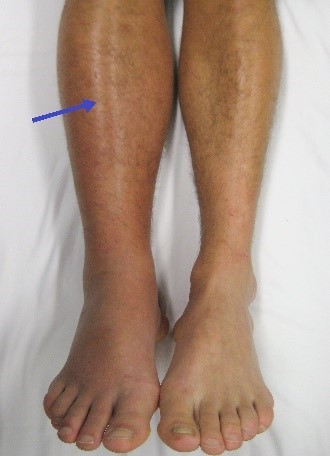Neurodiversity information for parents and young people
About blood clots
Blood clots are a natural response of our body to prevent bleeding. But they can also happen because of certain medical conditions or if you do not move for a long time.
Some people admitted to hospital are at risk of developing blood clots. Here we explain what can be done to try to prevent clots, both in hospital and at home.
Dangerous clots
DVT stands for deep vein thrombosis. This means a blood clot in a vein.
The clot is usually in the deep veins of the legs, but they can also happen in other veins of the body.
It is common for the clot to start in the calf. There, it interrupts blood flow in the leg. This causes symptoms such as swelling and pain.
If a piece of this clot breaks off it can travel up through the veins to the lungs. This is called a pulmonary embolism (PE). It can block blood flow in the lungs. This can cause breathing difficulties and even death.
DVT and PE are also known as Venous Thromboembolism (VTE).
Who is at risk
Almost anyone can have a blood clot. Sometimes they can just happen without any cause. However, certain factors increase the chance.
You are at risk of blood clots if:
- you have limited movement, such as when you are admitted to hospital or have an injured leg. This is because moving around less means the blood flows more slowly through the veins
- you are over 60 years old
- you are overweight
- you smoke
- you have an operation – especially hip or knee replacement, or surgery to your pelvis or abdomen
- you have previously had a blood clot
- you take the contraceptive pill or hormone replacement therapy (HRT)
- you have varicose veins
- you are pregnant or have had a baby in the past 6 weeks
- you are dehydrated.
Preventing clots
While in hospital
If you are admitted into hospital there are a number of things we may do to prevent blood clots. These will depend on your risk factors.
- Assess your risk of a blood clot.
- Give you information about your risk and how to prevent clots while in hospital.
- Encourage you to get up and move around. If you need assistance in moving, a nurse will help you.
- Encourage leg exercises.
- Fit you with compression stockings (knee-high elastic socks) or compression devices. These squeeze the leg to promote blood flow.
- Give you injections (blood thinners) that make the blood less likely to clot. If you need to continue these injections once you are home, we will teach you how to do them yourself.
Some of these medicines contain ingredients made from pork. If you need more information on this, speak to your doctor, nurse or midwife.
Leaving hospital
When leaving hospital, it is essential that you stay active and hydrated.
If your doctor prescribes anticoagulant medication for you to take at home, be sure to follow the prescribed schedule.
You may also be instructed to wear compression stockings. If so, make sure you follow the guidance given by the ward staff.
Signs of a clot
Tell any of the nursing or medical staff if you notice any of the following:
- chest pain that gets worse when breathing
- rapid heart rate
- rapid breathing
- pain in the leg
- warm feeling in the leg
- an area of swelling in the leg
- redness or change in colour of the leg.

Right leg with mild swelling and discoloration
© CC BY-SA
An ultrasound scan on the leg or a blood test is used to check for a clot in the leg. This will depend on your signs and symptoms.
A CT scan is used to check for a clot in the lung.
Treatment
Leg clot
If you have a blood clot you will be given blood-thinning medicines (also called ‘anticoagulants’). These reduce clotting. You will probably have to take these for at least 3 months.
If you need to continue blood-thinners once you are home, we will switch you to tablets (when possible) or teach you how to do the injections yourself.
Some of these medicines contain ingredients made from pork. If you need more information on this, speak to your doctor, nurse or midwife.
Lung clot
If the blood clot is in the lung and making you feel unwell, we will either give you medicine to dissolve the clot or offer you surgery to have it removed.
Recovery
Most people with a clot in their leg or lung recover completely within several weeks or months. Before you leave hospital, your doctor or specialist nurse will tell you what you need to know to aid your recovery. This may include:
- taking blood-thinner medicines
- exercise
- dealing with any pain or swelling
- travel, such as flying.
If you are planning a flight in the first month after a clot, get advice from your doctor or specialist nurse first.
More information
NHS website
Kingston and Richmond website
Thrombosis UK
Contact information
Clinical Nurse Specialist for clot prevention
Monday to Friday, 8am to 4pm
Telephone: